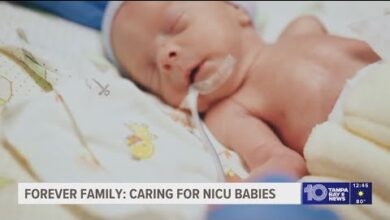Reducing checks for stable patients ‘would free up nurses’

Hospital nurses can monitor the vital signs of patients who are not seriously ill less often without putting them at risk of harm, a new study has suggested.
Led by University of Portsmouth researcher Professor Jim Briggs and funded by the National Institute for Health and Care Research (NIHR), the study hoped to free up nursing time by establishing a “safer and more efficient” approach to monitoring vital signs.
“Important nurse-patient interactions take place during vital sign monitoring”
Jim Briggs
The four-year study was split into two parts: an analysis of more than 400,000 patient records from two large NHS acute trusts and an observational study of vital sign checks by nurses and healthcare assistants at four NHS hospitals.
Researchers observed that a clinician, most often a nurse or healthcare assistant, took around five minutes on average to check a patient’s vital signs.
While these checks are important for monitoring a patient, researchers noted they could be annoying for patients and may disturb their rest and sleep, which can be important for recovery. They also noted that the checks can lead to a high workload for nurses.
The researchers said that, until now, there had been little evidence to suggest how long the time between observations should be.
However, in most UK hospitals, observation frequency is currently guided by a patient’s National Early Warning Score 2 (NEWS2), which takes into account vital signs results to determine their risk of deterioration.
Existing practice is to observe higher-risk patients more frequently, and from their findings, the researchers concluded that this approach “is objectively justified”.
They said patients with lower NEWS2 scores could be checked less often without endangering them.
This, the researchers found, would free up nurses’ time to allow for more frequent checks to take place for more acute patients.
They determined that risk to patients could be kept “within acceptable limits” using “fewer resources” than currently, relating to the checking of vital signs.
As well as reducing observations among less acute patients, the researchers suggested that “substantial efficiencies” were found when nurses grouped observations into rounds by observing multiple patients in a row.
The study team included researchers and clinicians from Oxford and Southampton universities and Portsmouth and Oxford hospitals, including well-known nursing workforce academic Professor Peter Griffiths.
Professor Griffiths, professor of health services research at the University of Southampton, said of the study: “Existing resources could be redeployed within a changed protocol to achieve better outcomes for some patients without compromising the safety of the rest.”

Peter Griffiths
Meanwhile, study lead Professor Briggs said that while the study suggested that less acute patients could be monitored less often, these regular checks should not be eliminated entirely.
He said: “It is worth noting that important nurse-patient interactions take place during vital sign monitoring.
“So, reducing the frequency of monitoring might also reduce the opportunities for the nurse to notice other signs about the patient’s condition and for the patient to ask questions about their care, for example.
“That’s why regular interactions between patients and staff should not be eliminated completely under new monitoring processes.”
The study stated that some stakeholders in the study suggested a short “check-in” for lower-risk patients could replace the vital sign check, which would save resources without eliminating face time with clinicians.
“We can free up nursing time to focus on those who need more frequent observations”
Anoop Chauhan
Professor Peter Watkinson, professor of intensive care medicine at Oxford University Hospitals NHS Foundation Trust, who was involved with the research, added: “Improvements to current recommendations for how often a patient in hospital should have vital signs taken could both free up time to provide other care and improve the speed with which a change in these vital signs is recognised.”
Portsmouth Hospitals University NHS Trust and Isle of Wight NHS Trust chief research officer Professor Anoop Chauhan said the study provided “valuable insights” for improving the efficiency of nursing care in hospitals.
“By identifying opportunities to reduce unnecessary monitoring for lower-risk patients, we can free up nursing time to focus on those who need more frequent observations, ultimately enhancing patient safety and care quality across our organisations,” Professor Chauhan added.







